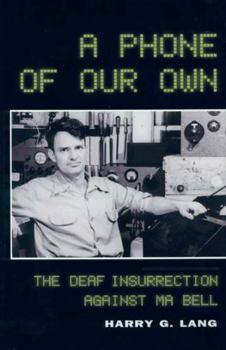A Phone of Our Own: A Reconstruction
Select Format
Select Condition 
Book Overview
In 1964, of the more than 85 million telephones in the United States and Canada, less than one percent were used regularly by deaf people. In that same year, three enterprising deaf men, Robert H.... This description may be from another edition of this product.
Format:Hardcover
Language:English
ISBN:1563680904
ISBN13:9781563680908
Release Date:May 2000
Publisher:Gallaudet University Press
Length:256 Pages
Weight:1.35 lbs.
Dimensions:0.9" x 6.3" x 9.4"
Customer Reviews
4 ratings
A HEARING PERSON APRECIATES
Published by Thriftbooks.com User , 16 years ago
PRIOR TO THE TTY DEAF PERSONS WERE ALMOST TOTALLY ALONE UNLESS THEY HAD A HEARING PERSON AROUND TO MAKE CALLS ETC-THE BLIND DID NOT HAVE THIS---WE HEARING PERSONS WILL NEVER KNOW HOW THEY PERSISTED PERSISTED PERSISTED TO BECOME EQUALS IN A HEARING WORLD--IS MY GOOD FORTUNE IN LIFE TO KNOW (SINCE 1948) ONE OF THE PRINCIPALS OF THIS WONDERFUL BOOK... JAMES C MARSTERS DDS--THATS CORRECT DDS WE WERE CLASS MATES-AND THE IDEA WAS COMING AROUND IN HIS HEAD AS EARLY-IN MY KNOWLEDGE--AROUND 1950---sooooooo read on THEY CLIMED THE MOUNTAIN.................................................
Remarkable story of innovation & the enduring human spirit.
Published by Thriftbooks.com User , 23 years ago
Less than one percent of the 85 million telephones in the U.S. and Canada in 1964 were used regularly by the deaf. That's when Robert Weitbrecht (physicist with the Stanford Research Institute), James Marsters (orthodontist), and Andrew Saks (businessman) started the process that led to deaf people around the world possessing an affordable phone system that they could use. All three of these enterprising men were also deaf. Harry Lang's A Phone Of Our Own: The Deaf Insurrection Against Ma Bell is the fascinating story of how these three diverse men collaborated to solve the technical difficulties of developing a coupling device for a teletypewriter that would translate sounds into discernible letters. With the help of an expanding corps of deaf advocates, ATT and FCC resistance to this technological innovation was overcome and a portable, fully accessible, and affordable telephone system came into being for the deaf community. A Phone Of Our Own is a remarkable and enduring story of innovation and the enduring human spirit.
A Phone of Our Own
Published by Thriftbooks.com User , 23 years ago
A phone of our own. From the very first sentence of the introduction "For nearly a century after the advent of the voice telephone, we deaf people were without a phone of our own". Author Harry G. Lang takes the reader by the hand and brings the very personal struggle of the Deaf people to the reader. He brilliantly brings to the public eye not only the Deaf persons responsible for bringing us the TTY that we enjoy so much, but also the countless numbers of Deaf people who worked tirelessly behind the scenes. It is not a book about one Deaf person but many Deaf people in their ongoing struggle to communicate. This book is a masterpiece of writing and brings a renewed pride within the Deaf community. I highly recommend this book for everyone, Deaf and hearing.
Great story about a battle for equal access!
Published by Thriftbooks.com User , 23 years ago
As always, Dr. Harry Lang writes about topics pertaining to the Deaf world and its ongoing attempt to make their way in a hearing world. This book is a magnificent story about the battle between big corporations and a small group of people who were striving to find a way to communicate with each other and with the hearing world. It is very ironic that Alexander Graham Bell was attempting to find a way to assist the Deaf (his own wife was Deaf) when he started developing the phone, yet his creation became the bane of our existence. Until the development of the computer and email, the phone was the ultimate barrier for those with hearing impairments to participate in the 'normal' world through education, employment, and necessaries such as calling the doctor for an appointment. Dr. Lang tells the story of 3 courageous and very different men who wanted to rectify this communication deficit for the hearing impaired community. What started out in homes and garages much as the history of PCs did in the San Francisco Bay Area, spread throughout the U.S., and much of the effort had to be spent trying to get corporations such as AT & T to cooperate. It is unbelieveable the amount of obstacles raised by the very group who would benefit (in increased revenue from a priorly non-using community) were the ones who made things so difficult for these men. Yet persistence from all of them led to an invention/tool which is much used now and taken for granted by all of us who became deaf later in life. This history is well-written and well-documented, and it should be required/recommended reading for those in communications, as well as those who are deaf or who work with the deaf. Changes in the TTY, increased private/public computer use, and changes in federal laws such as the ADA and rulings by the FCC have led to increased use of this method of communication, and the increasing availability of TTYs in public places. It has also led to innovations in computer use, and prompted attitudinal changes which were much needed. Karen Sadler, Science Education, University of Pittsburgh




